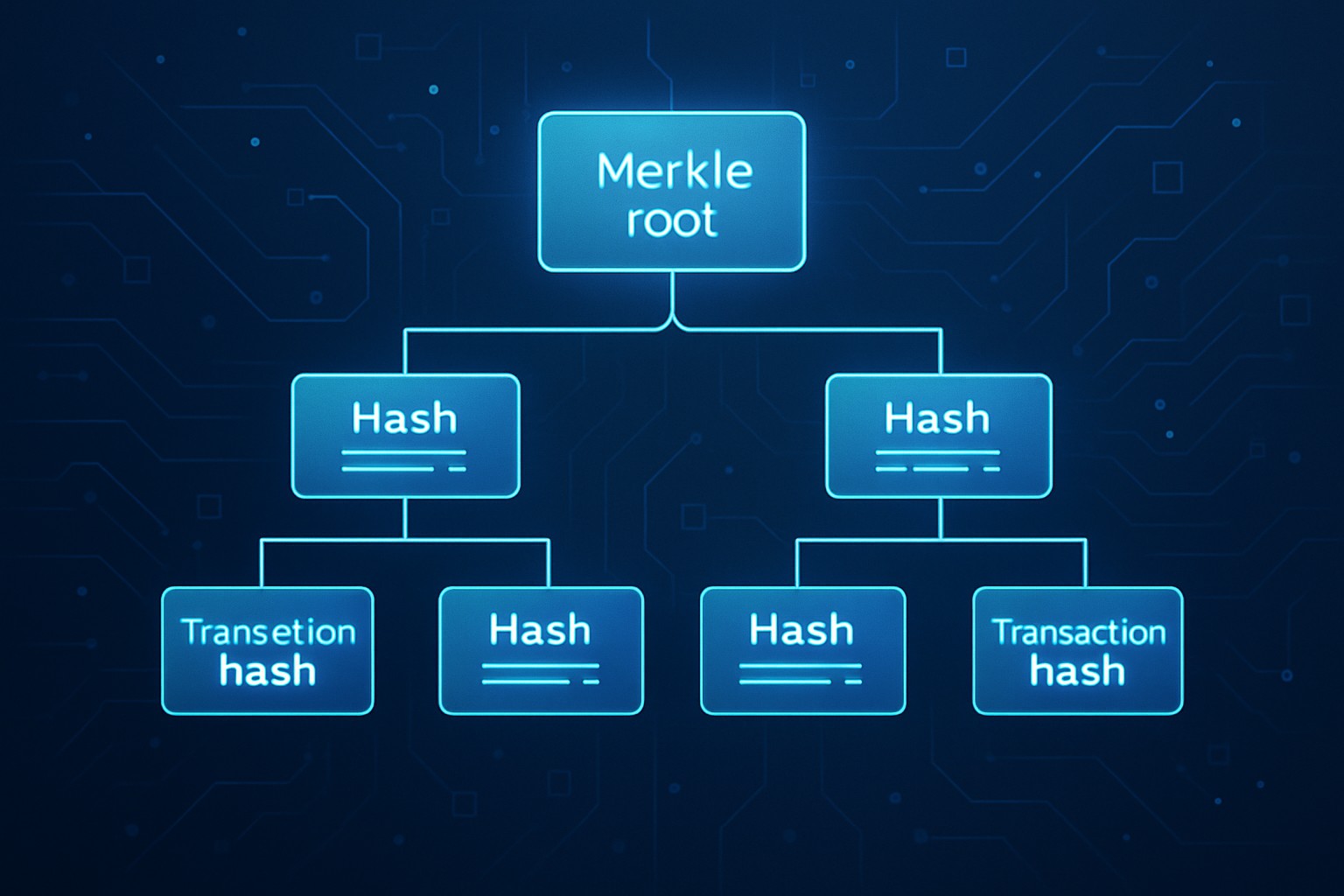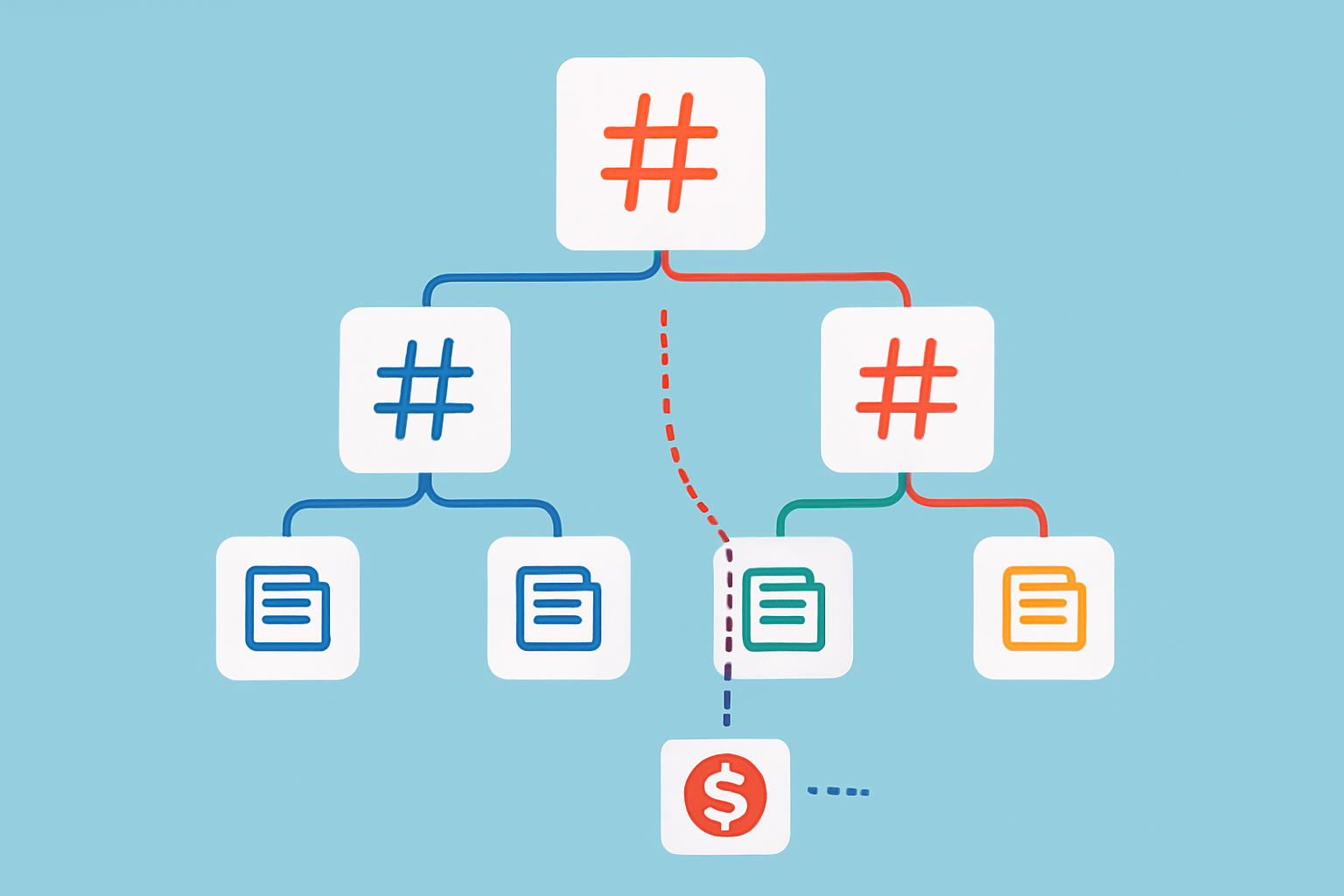How Merkle Tree Works to Verify Transactions?


Transactions truly form the backbone of blockchain networks and making sure they get verified both securely and efficiently is absolutely important. One handy tool in this whole process is the Merkle tree—a clever data structure that not only speeds up transaction validation but also keeps everything neatly intact.
What exactly is a Merkle Tree, anyway?
A Merkle tree sometimes called a hash tree is a clever type of binary tree designed to quickly summarize and verify huge piles of data without the tedious process of checking each item individually. It works its magic by hashing chunks of data and neatly arranging them into a tree structure.
- A Merkle tree is a neat little binary tree where each leaf node holds a hash of some data, think of it like a snapshot of a transaction.
- Every non-leaf node carries a hash made by blending together the hashes of its two child nodes, kind of like hashing’s way of teamwork.
- The Merkle root acts as the ultimate summary or fingerprint of all the data nested beneath it.
- Hashing means even the tiniest tweak in the data flips the hash completely, which is a clever trick that helps keep the data’s integrity rock solid.
- Merkle trees are a real lifesaver when it comes to verifying huge piles of data—they let you check just a handful of hashes instead of slogging through every single piece.
Think of a Merkle tree like a family tree but instead of relatives it’s tracking files and folders on your computer. Each file gets its own unique fingerprint or hash kind of like a digital signature. When files come together in a folder that folder’s fingerprint is crafted by mixing all the individual file fingerprints into one.
How Exactly Does a Merkle Tree Help Keep Transactions in Check?
Verify transactions in a blockchain block by building a Merkle tree from all the transaction data. Instead of poking through each transaction individually the Merkle tree bundles them up and makes integrity checks quick and efficient.
Each transaction gets hashed to create a unique fixed-length value that sums up everything inside it.
Next, these transaction hashes are paired, and each duo's two hashes are mashed together and hashed again to create a new hash.
This dance of pairing and hashing continues up the tree step by step until you have a single hash at the top.
The Merkle root hash is the grand summary that wraps up all the transactions inside the block.
You don’t need to sweat over verifying every single transaction. Instead, you just take a quick peek at the Merkle root. Since that root is basically a hash that sums up all the transaction hashes bundled together, even a tiny change in one transaction will totally flip the Merkle root.
Merkle Proof A Friendly Guide to Verifying a Single Transaction
The Merkle root neatly wraps up all transactions but often you just want to double-check that a specific transaction made it into the block without downloading the whole shebang. A Merkle proof or Merkle path steps in—a clever trick to verify inclusion efficiently and with a dash of privacy.
- A Merkle proof is basically a neat set of hashes that proves a transaction is part of a block without revealing all the other transactions inside.
- It’s made up of the sibling hashes needed to trace the path from one specific transaction leaf to the Merkle root.
- By hashing the transaction with these sibling hashes one step at a time, you end up with a root hash that should perfectly match the known Merkle root.
- This clever process lets lightweight clients verify a transaction’s inclusion with confidence even if they don’t have access to the entire blockchain data.

The diagram above gives a clear glimpse into how a Merkle proof works by tracing a specific transaction's hash up the tree, mixing in sibling hashes along the way to reconstruct and verify the Merkle root.
Why Do Merkle Trees Really Matter When It Comes to Verifying Blockchain Transactions?
Merkle trees aren’t just dry abstract data structures tucked away in textbooks. They play a important role in making blockchain verification practical and rock-solid secure. By increasing the speed, security and trustworthiness of transaction verification, Merkle trees help blockchains run smoothly and efficiently.
- They cleverly cut down the amount of data needed for verification, letting nodes confirm transaction integrity without downloading whole blocks — a real time and bandwidth saver.
- They make it possible for lightweight or SPV clients to participate securely even on shoestring resources.
- The linked hash design acts like a watchdog against data tampering because tweaking a single transaction changes the Merkle root and throws up a red flag.
- By efficiently summarizing transactions they help blockchain networks scale to handle mountains of data.
- They support quick and reliable transaction confirmations which are key for keeping user trust alive in blockchain systems.
The Merkle tree acts like a trusty digital fingerprint for thousands of transactions, giving you a quick way to confirm that everything’s in one piece without slogging through each bit one by one.
Common Misunderstandings About Merkle Trees That Trip People Up
Merkle trees play a important role but are often misunderstood or overlooked.
- Merkle trees are actually pretty straightforward. They rely on simple hashing and pairing in a tree-like structure. It is nothing fancy but clever in its simplicity.
- You don’t need to download an entire block to verify transactions with Merkle proofs. Just grab the specific hashes involved and save a lot of hassle.
- Merkle trees aren’t trying to replace major consensus methods like Proof of Work or Proof of Stake. Instead they play a different supportive role.
- Not all blockchain data is publicly available. Encryption and privacy measures keep some information protected.
- On their own Merkle trees don’t magically secure transactions but they are important team players. They help broader consensus protocols by keeping data integrity intact.
How Merkle Trees Play Their Part in Blockchain Ecosystems
A handful of well-known blockchains have Merkle trees woven right into their core protocols. Take Bitcoin and Ethereum, for example—they lean on these Merkle structures to verify and validate blocks efficiently.
| Blockchain Network | Use of Merkle Tree | Purpose | Benefits in That Ecosystem |
|---|---|---|---|
| Bitcoin | Uses transaction hashes bundled within each block | Confirms that transactions are included and intact | Lets lightweight SPV clients do their thing while saving on bulky data downloads |
| Ethereum | Employed in both transaction and state trees | Keeps transactions and world state neatly organized and verifiable | Plays a key role in speedy syncing and trustworthy state verification, helping keep things humming smoothly |
| Litecoin | Works much like Bitcoin’s method | Verifies transactions with a familiar touch | Delivers efficient validation without skimping on security, giving a bit more peace of mind |
| Hyperledger Fabric | Woven into the ledger’s structure in permissioned blockchains | Verifies data blocks where permission matters | Builds trust in private networks while trimming down overhead, a practical balance if you ask me |
| Zcash | Uses Merkle trees specifically for shielded transactions | Enables privacy-preserving proofs without breaking a sweat | Supports secure and efficient verification of those private transactions, making privacy feel less like a mystery |
Light clients often called Simplified Payment Verification (SPV) clients use Merkle proofs to verify transactions without downloading entire blocks. They request the Merkle root and a few related hashes which dramatically trims storage and bandwidth requirements while keeping verification trustless.
A Step-by-Step Guide to Verifying Transactions with a Merkle Tree (Because Trust But Verify Never Gets Old)
Checking whether a transaction has made it into a block using Merkle trees is actually pretty straightforward once you’ve got the right proof data in hand. This clear guide gently walks you through the steps to verify if a transaction truly belongs to a block, using Merkle proofs along with the known Merkle root.
Grab the transaction hash you want to verify, along with all the sibling hashes that form the proof path—think of them as your trusty sidekicks on this hashing adventure.
Combine and hash your transaction hash with each sibling hash one step at a time, making sure to follow their exact position (left or right) in the tree—no cutting corners here.
Keep at it, hashing along the path until you reach the very top and compute that final hash—the big boss hash.
Pit this final hash against the published Merkle root from the blockchain to confirm your transaction’s rightful spot and that it hasn’t been tampered with along the way.
More blockchain explorers and wallets these days are showing Merkle proof data right upfront, making it a whole lot easier for users to double-check transactions. When you are diving into these tools, keep an eye out for transaction details that spell out Merkle paths or proof data. This little nugget lets you verify that your transaction is part of the blockchain puzzle on your own, no need to have the entire chain at your fingertips.
Frequently Asked Questions
Why cannot blockchains just verify transactions one by one instead of using Merkle trees?
Checking transactions one by one would take a huge amount of time and computing power, especially when blocks get big. Merkle trees let nodes approve thousands of transactions quickly by verifying just a single hash, the Merkle root, while still catching any funny business. This clever trick keeps blockchains scalable and lets lightweight clients work without breaking a sweat.
How does a Merkle proof actually prove a transaction is valid?
A Merkle proof provides the smallest batch of hashes needed to climb from your transaction to the Merkle root. By hashing these step by step, if the root you calculate matches the blockchain's official root, it’s like a mathematical high-five confirming your transaction is in there and hasn’t been tampered with.
Can someone fake a Merkle proof to include invalid transactions?
Nope, that won’t fly. Each hash in the proof is tightly linked to the others. Even changing one hash means you’d have to redo the entire chain of hashes up to the root — a Herculean task thanks to cryptographic hashing. That’s why Merkle proofs aren’t about trusting a third party but solid, ironclad math.
Do all blockchains use Merkle trees the same way?
Most blockchains use Merkle trees to verify transactions but don’t all follow the same rules. Take Ethereum, for example. It uses three different Merkle trees: transactions, receipts, and state, all wrapped in its Patricia-Merkle Trie structure. Meanwhile, some newer blockchains adjust Merkle trees to better fit goals like privacy or fast verification.
As a regular user, when would I interact with Merkle proofs?
You probably encounter Merkle proofs more often than you think. Lightweight wallets rely on them to confirm your transactions. When you view transaction details on explorers, you often see the Merkle root and inclusion proof info. If you’re feeling adventurous, advanced users can even check these proofs themselves for extra peace of mind.






